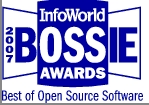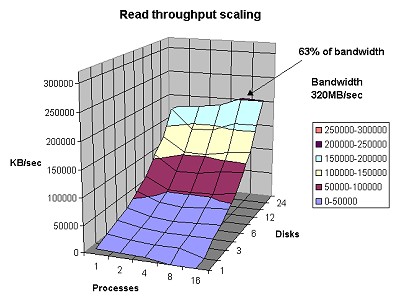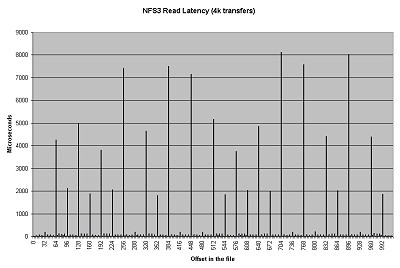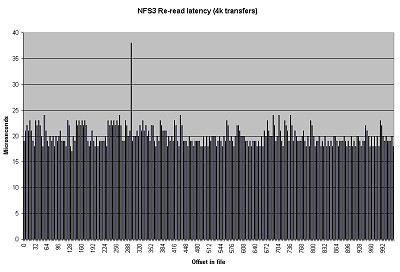IOzone Filesystem Benchmark

|
IOzone is a filesystem benchmark tool. The benchmark generates and measures
a variety of file operations.
Iozone has been ported to many machines and runs under
many operating systems.
Iozone is useful for performing a broad filesystem analysis of
a vendorís computer platform. The benchmark tests file I/O performance for the following
operations:
Read, write, re-read, re-write, read backwards, read strided,
fread, fwrite, random read, pread ,mmap, aio_read, aio_write
|
 |
|

Benchmark Features:
- ANSII C source
- POSIX async I/O
- Mmap() file I/O
- Normal file I/O
- Single stream measurement
- Multiple stream measurement
- Distributed fileserver measurements (Cluster)
- POSIX pthreads
- Multi-process measurement
- Excel importable output for graph generation
- Latency plots
- 64bit compatible source
- Large file compatible
- Stonewalling in throughput tests to eliminate straggler effects
- Processor cache size configurable
- Selectable measurements with fsync, O_SYNC
- Builds for: AIX, BSDI, HP-UX, IRIX, FreeBSD, Linux, OpenBSD, NetBSD,
OSFV3, OSFV4, OSFV5, SCO OpenServer, Solaris, MAC OS X, Windows (95/98/Me/NT/2K/XP)
|
While computers are typically purchased with an application in mind it is also likely
that over time the application mix will change. Many vendors have enhanced their operating
systems to perform well for some frequently used applications. Although this accelerates
the I/O for those few applications it is also likely that the system may not perform well
for other applications that were not targeted by the operating system. An example of this
type of enhancement is: Database. Many operating systems vendors have tested and tuned the
filesystem so it works well with databases. While the database users are happy, the other
users may not be so happy as the entire system may be giving all of the system resources to
the database users at the expense of all other users. As time rolls on the system administrator
may decide that a few more office automation tasks could be shifted to this machine. The load
may now shift from a random reader application (database) to a sequential reader. The users may
discover that the machine is very slow when running this new application and become dissatisfied
with the decision to purchase this platform. By using Iozone to get a broad filesystem performance
coverage the buyer is much more likely to see any hot or cold spots and pick a platform and operating
system that is more well balanced.
|
The NFS3 Read Latency graph shows the latency of 4k read operations over an NFS Version 3
filesystem mounted on a client running Iozone. Click on image for a larger view.
|
 |
|

|
The NFS3 Re-read Latency graph shows the re-read latency of 4k reads over an NFS Version 3
filesystem. One can clearly see the effects of the client side cache. Here the latencies
are the same as local buffer cache latencies. Click on image for larger view.
|
Download Documentation:
[ Iozone License ]
[ PDF ]
[ Postscript gzip ]
[ MS Word Doc ]
Download Source:
[Latest tarball]
[Latest files]
[Stable tarball]
[Stable files]
[Linux SRPM ]
[Linux x86_64 RPM ]
[Windows ]
[Contact capps@iozone.org to purchase the Excel spreadsheet with extensive Visual Basic macros to automatically generate the 3D graphs. Click to see the example output. ]
Typical Linux result example with annotations.
(Click on tabs at the bottom of the graph to see all of the results):
Linux Iozone graph example.
Typical Windows2000 result example with annotations.
(Click on tabs at the bottom of the graph to see all of the results):
Windows 2000 Iozone graph example.
Apple's Xserver.
(Click on tabs at the bottom of the graph to see all of the results):
Apple's Xserver.
Comparisions of various filesystem types.
(Click on tabs at the bottom of the graph to see all of the results):
File system comparisons.
NFS Presentation:
Powerpoint: NFS PowerPoint presentation.
MS Word: NFS MS Word presentation.
PDF : Revised NFS Client performance presentation.
MS Excel: NFS Throughput example.
Questions: email capps@iozone.org
Interested in NFSV4 ?: NFSV4 info
Iozone Lab Tour 1: Click Here
Iozone Lab Tour 2: Click Here
Google Cardboard 360 VR image:

Don't forget to tryout the new "fileop" that is included in the Iozone kit.
Fileop graph example.
Other benchmarks folks might find interesting are:
See: SPEC SFS2014 official web site
See: Un-official SPEC SFS 2014 User Forum site
See: SPECstorage Solution 2020 official web site
Sponsors
The following companies have donated equipment to the Iozone lab to promote the development and testing of Iozone, SPECsfs2014 and SPECstorage Solution 2020 benchmarks, as well as future SPEC Storage benchmarks:
 |
Netapp |
Apple |
 |
Use of official logos is with permission of the respective companies.
Contributors
The following companies and individuals have contributed time, resources, or code to Iozone, netmist, or other Iozone projects:
Don Capps, Carol Capps, Darren Sawyer, Jerry Lohr, George Dowding, Gary Little, Terry Capps, Robin Miller, Sorin Faibish, Raymond Wang, Tanmay Waghmare, Yansheng Zhang, Vernon Miller, Nick Principe, Zach Jones, Udayan Bapat, William Norcott, Isom Crawford, Kirby Collins, Al Slater, Scott Rhine, Mike Wisner, Ken Goss, Steve Landherr, Brad Smith, Mark Kelly, Dr. Alain CYR, Randy Dunlap, Mark Montague, Dan Million, Gavin Brebner, Jean-Marc Zucconi, Jeff Blomberg, Benny Halevy, Dave Boone, Erik Habbinga, Kris Strecker, Walter Wong, Joshua Root, Fabrice Bacchella, Zhenghua Xue, Qin Li, Darren Sawyer, Vangel Bojaxhi, Ben England, Vikentsi Lapa, Alexey Skidanov
The Windows version of Iozone uses the Cygwin runtime. The sources for this
may be obtained by clicking on the link below. However, I strongly recommend that the user visit http://www.cygwin.com and obtain everything from the original site. They have great stuff there and you'll thank me :-)
Cygwin DLL source code
I also volunteer at a special needs school. They are a non-profit school for special needs children (K->12). The link below is a quick ref and contact list for the school. (Any donations would be very welcome :-)
Great Lakes Academy.
On the topic of Encryption, I'm on the tech side of the house. Encryption is what makes ecommerce safe, protects our banks, power grid, and our national security. Any introducton of backdoors, for law enforcement, is insane. Backdoors either exist or they don't. If they do then hackers and foreign governments can gain access.
To demonstrate my point here is a link to some encryption software that I wrote that has no backdoors, and can be used for whatever purpose you wish. The code is open source, and you get the full source code. This kit provides the routines needed to encrypt text or binary data. It is a symmetric algorithm. The keys to decrypt must be exchanged with the recipient via a seperate communication. The user should never reuse any keys from previous transmissions.
An Encryption kit with no backdoors.
Rotor encryption document
Last Updated: Jan 23rd 20:00:00 PST 2016
webmaster@iozone.org
|







